The Bridge of Life Museum on Panama's Amador Causeway
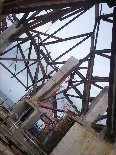
Reminiscent of the drawings of Dr. Zeuss, the Frank Gehry-designed "Bridge of Life" BioMuseo is under construction on Panama's Amador Causeway. The building, without a single ninety degree angle in site, has been in the works since 2004 with an original completion date of 2006. Now, with a September 2010 completion date scheduled for the building and September 2011 date for completion of exhibits the BioMuseo is giving tours of the construction site. On a rainy Friday afternoon I took the tour along with a dozen others. Starting in the visitor center, the staff presented an overview of the museum's purpose, unique construction, and progress. Then we donnned hard hats and vests to explore the world of Frank Gehry. Located between the Pacific and Panama Bay the museum will have a gorgeous view of the city and ships passing in and out of the Panama Canal.
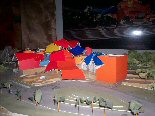 With the cardboard model of the completed museum in mind we tromped up and down ramps, ducked under yellow ribbons, and, mostly, skirted puddles for more than an hour as the construction manager took us around the site.
With the cardboard model of the completed museum in mind we tromped up and down ramps, ducked under yellow ribbons, and, mostly, skirted puddles for more than an hour as the construction manager took us around the site.
The theme of the BioMuseo is the diversity of life in Panama and in the seas around Panama. The visitor center introduction was part geology lesson. It turns out that there was a time when North and South America were not connected and the ocean current flowed through the large gap. Due to a prolonged volcanic uplift Panama came into being and connected the two land masses as it separated the oceans. According to the speaker, Europe's relatively mild climate for a set of Northern Countries comes from the Gulf Stream which is a result of the creation of Panama. The circulating currents in both Atlantic and Pacific came to be when Panama came into being.
Because of the unique position of Panama as a land bridge connecting North and South America there are huge numbers of species of birds, insects, trees, etc. in Panama. Panama has more native bird species than all of North America. The museum will not only feature exhibits such as marine life of both the Caribbean and Pacific with huge aquaria. The BioMuseo will be a research center to study what allows Panama to maintain such diverse species in such a small country.
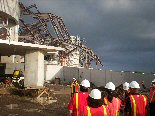 The Tour
The Tour
The foundations of the Biomuseo are done as are the walls. There is three foot thick reinforced concrete in the wing that will house the two great aquaria. The roof panels will be brightly painted just like in the mode. The lack of any flat roof surface will make sure that no water leaks into the facility and the structural steel roof supports appear to be built to withstand substantially more wind than Panama ever gets.
Because of the "non repetitive" nature of construction at the BioMuseo the construction yard has a huge number of seemingly random parts with detailed coding as to where each nut, bolt, and connector goes.
As we toured, a 14 man work crew was finishing putting up scaffolding to allow the finishing of a portion of roof and wall facing the bay. External cement walls will be dressed with two inch think insultation to reduce heat exchange and protect the complex structure against the forces of expansion and contraction.
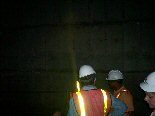 Great halls that will house exhibits are now quiet and only lit by indirect sunlight. Parts of the main floor are storage areas for materials and, without much of the roof, there were a lot of puddles to walk through. However, the building look very sturdy and professionally built. The building crew of 14 can expand when there is more to do and with the current crew and funding, according to Claudia De Leon with communications for the Biomuseo.
Great halls that will house exhibits are now quiet and only lit by indirect sunlight. Parts of the main floor are storage areas for materials and, without much of the roof, there were a lot of puddles to walk through. However, the building look very sturdy and professionally built. The building crew of 14 can expand when there is more to do and with the current crew and funding, according to Claudia De Leon with communications for the Biomuseo.
The BioMuseo is alive and well and due to make a huge impression when the building is finished and a bigger impression when its exhibits are in place.
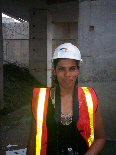 Tours are every two weeks and limited to 15 people.
Tours are every two weeks and limited to 15 people.
If seeing the museum under construction interests you contact:
Clauia De Leon
Asistente de Comunicaciones, Biomuseo, 314-0097, cdeleon@biomuseop
The tour is free and there is plenty of parking. Just drive out the causeway and ;ull off at the street before the large, preying mantis-like steel girders...
